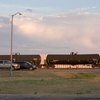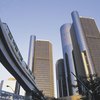A train is a series of rail cars coupled together and pulled by an engine known as a locomotive. The locomotive can pull or push the cars. It was originally powered by steam, but today, diesel or electric locomotives power most trains. Trains with large numbers of rail cars often require more than one locomotive.
Locomotives
Steam locomotives were the primary source of power for trains from the early 19th century until the 1950s. Steam engines work by burning coal or wood to heat a boiler that is partially filled with water. Once the water boils, steam is released into the steam pipe and ultimately into a cylinder, where pressure pushes a piston that is connected to one wheel by a piston rod. This wheel is attached to the other wheels and the train is propelled forward as the piston moves back and forth causing the wheels to move together. Today, locomotives are primarily powered by diesel or electricity.
Passenger Cars
Passenger trains are designed to transport people over long distances or on short commutes. Train travel was once the primary method of traveling across the country, but it declined in the United States as air travel became more common and more interstate highways were built. Long distance passenger trains consist of passenger cars, dining cars and sleeping cars. Sometimes freight cars are added to passenger trains to transport freight to areas not easily reached by truck.
Freight Cars
There are many kinds of freight cars that are used to transport goods by rail. The box car is the most common type of freight car and is completely enclosed. Open-top hoppers are freight cars with no roof that have openings underneath for unloading freight like coal. Closed hoppers carry goods, like grain, that need to be protected from the elements, and flat cars are designed to carry containerized cargo that is transferred from semi-trucks. Other types of freight cars include refrigerated cars, tankers, bulkers and auto racks.
Caboose or Flashing Rear-End Device
The caboose was once the last car on nearly every train. It was used to shelter the crew, who often had to disembark the rear of the train for switching, or to protect the train from robbers when it was stopped. The conductor often had a desk in the caboose where he completed his paperwork. By the 1980s, technology had advanced and cabooses became unnecessary for safety, so the FRED or Flashing Rear-End Device replaced the caboose. The FRED uses computerized technology to detect braking, coupling or other problems and alert the engine crew. It also provides a flashing red light to warn other trains.
References
- "C Is For Caboose"; Traci Todd; 2007
- "Trains"; Lynn Curlee; 2009
- "Transportation"; Philip Wilkinson and Michael Pollard; 1994
Photo Credits
- train image by dinostock from Fotolia.com




